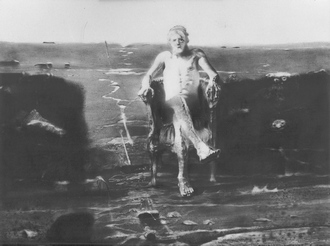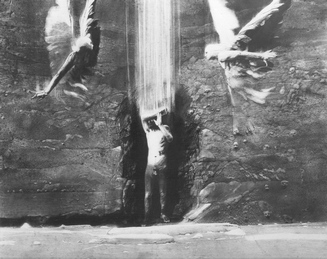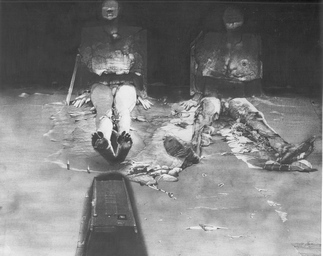ABOUT ROJ FRIBERG
The Swedish artist, Roj Friberg (born in 1934), has recently
exhibited a large number of paintings in the picturesque gallery spaces
situated within the former sawmill of Soli Brug, near Oslo.
The paintings shown were
later works, executed in a distinctive technique using wax-based colours,
where emergent motifs are at times scraped into existence. In no
less than three separate buildings one could see the staying-power of Friberg’s
motifs of choice: marine views, the facades of Central European houses
untouched by EU restoration projects, interiors of old manor houses, and
portraits of rulers and of those who are ruled. And all of this is
done in a technique that approaches perfection. Friberg’s buildings
display his illusionistic mastery. His waves have the elegance of
classic Chinese brushwork. Nevertheless, having said this, we have
hardly said anything at all.

To use a literary term, Friberg
is more a “magic realist” than a commentator on daily life. His gaze
goes inward, abandoning itself to its own flow. His pictures have
something that is trancelike and intensified, while they are at the same
time endowed with tautness through his mastery of the craft. Even
though Roj Friberg’s talent tends by nature toward draughtsmanship, it
is nevertheless fitting to compare him to the mature Goya — where that
which appears clear and easy has behind it a whole life of the painter’s
toil. And, as in Goya, the faces and the scenes seem to have emerged
straight from the darkness, the darkness found in the inner vision.

On the day of the opening I got
a chance to sit down with the artist for a few minutes of conversation.
We sat by the old mill pond, surrounded by large dragonflies such as I
had only seen in Kurosawa’s last film, Dreams. The painter confirmed
one of my impressions from his paintings: as he works he is indeed conscious
of an approaching ecological catastrophe — of a poisoning that not only
reaches down to the roots of trees, but that enters into our houses and
our dreams. To do harm to the foundation of one’s being is to perpetrate
a moral harm that etches its way not only into public discourse but into
language itself. And, one might add here, into his pictorial world
of decaying salons, crackling facades and eroding statues. It is
as though time itself is corroding the motifs in his paintings, time that
is running out.

Indeed, Roj Friberg would be
less true as an artist were it not that he confesses of his own accord
that he does not fully know what he is doing. “It’s something you
can’t put into words,” he tells me. Art is not born of an environmental-political
need, but comes from a question about ourselves to ourselves. He
explains that he enters into creativity “to find intoxication”. True
creativity involves letting go of self-control. The creative process
of painting, he says with an amused smile, is “like slow love-making”.
Yet art’s task is spiritual.

Anyone wishing to do so can of
course write off Friberg as a romanticist, but if we go back to Chauvet
and Lascaux, we find that it is Friberg who has the millennia on his side.
As for me, I left the show not only glad to have seen such powerful art,
but also having a newly acquired sense of peace: the creative impulse in
European pictorial art is by no means done for. There is still life
in the corpse. There may be rot at the root of the tree, but the
tree is still green and its branches are budding.
|

![]() © 2003-2005 Ars Interpres Publications.
© 2003-2005 Ars Interpres Publications.